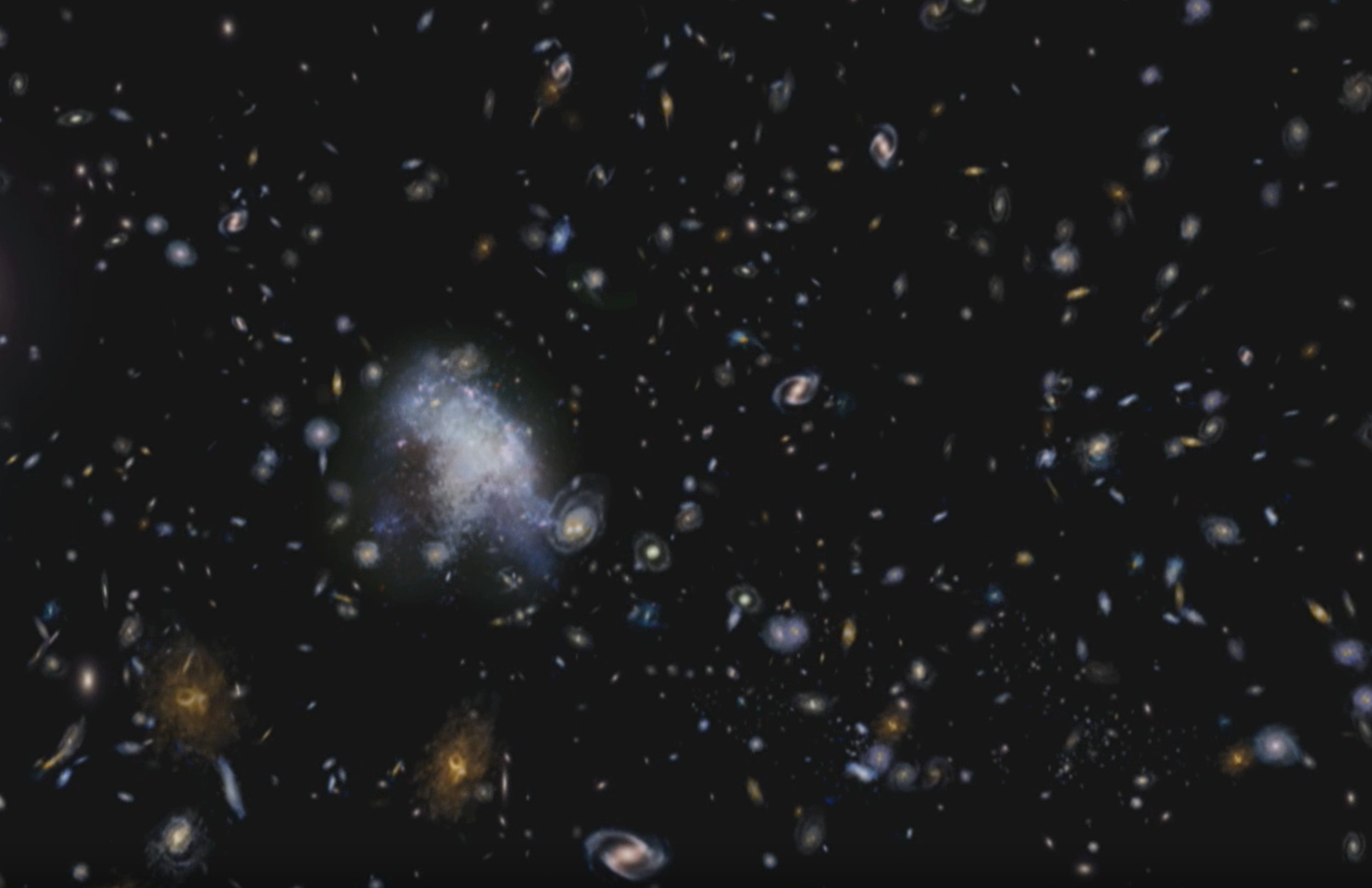Dark energy may have caused the universe to expand rather than contract
Known as ΛCDM, the standard model of cosmology weaves together dark energy, dark matter, and Einstein’s general relativity.

Could dark energy’s role have reversed over time? (CREDIT: NASA)
For more than two decades, the standard model of cosmology has stood as a reliable guide to the universe. Known as Lambda Cold Dark Matter, or ΛCDM, it weaves together dark energy, dark matter, and Einstein’s general relativity into a framework that explains how galaxies formed, how space has expanded, and why cosmic microwave background radiation looks the way it does.
This model has solved countless puzzles about the cosmos. Yet, as telescopes sharpen their view, the picture has become less tidy. Two stubborn problems—the so-called Hubble tension and the sigma-8 tension—refuse to go away.
At the heart of the trouble lies dark energy, a mysterious ingredient that makes up nearly 70 percent of the universe. According to ΛCDM, dark energy has a fixed positive value that steadily drives cosmic acceleration. But what if this assumption is wrong? What if dark energy, or vacuum energy, didn’t always push the universe outward?
A new study published in the journal arXiv, proposes just that. It suggests the vacuum energy may once have pulled inward before switching signs to power today’s expansion. In plain terms, the cosmos may have flipped from braking to accelerating.
Why the Standard Model Falls Short
The Hubble tension is the most famous inconsistency. When you measure how fast the universe is expanding today using nearby galaxies and exploding stars, you get a higher number than when you infer the expansion rate from the early universe using the cosmic microwave background. The two methods disagree by enough that simple errors are unlikely.
The sigma-8 tension, though less well known, adds to the unease. It measures how strongly matter clumps across cosmic scales. Some surveys of galaxies and gravitational lensing suggest less clumping than ΛCDM predicts. Put together, these tensions hint that something in our story of dark energy and expansion might be missing.
That missing piece, according to the new research, could be a dramatic phase change in dark energy’s role. The idea is that vacuum energy once carried a negative sign, pulling space inward like a faint brake, before flipping positive and becoming the gentle accelerator it is today.
Related Stories
- Exoplanets may capture dark matter and collapse into black holes
- Two bold dark matter theories could reveal the universe’s missing mass
In scientific terms, the universe may have shifted from an anti-de Sitter phase to a de Sitter phase. If true, that shift could ease both the Hubble and sigma-8 tensions at once. Earlier studies hinted at this possibility, showing that a sudden sign change helps multiple data sets fit better together.
This new work sharpens the question: when the flip happened, did both phases bend space with the same strength, or could the degree of curvature have differed before and after? That extra detail adds another dial to turn in the model. The researchers wanted to know if introducing this extra freedom helps explain the data—or just adds clutter.
How They Tested the Idea
To find out, the team of researchers from The City University of New York, turned to a statistical tool called Markov Chain Monte Carlo. It’s designed to search through vast ranges of possible values and identify those that best match observations. The analysis was run using the MontePython code linked to the CLASS Boltzmann solver, modified to handle a sudden switch in vacuum energy.
The data set was rich and diverse. It included the 2018 Planck measurements of the cosmic microwave background, carefully chosen baryon acoustic oscillation results that avoid building in too many assumptions, the Pantheon+ supernova compilation with local calibrators, and weak-lensing surveys from the KiDS-1000 program. These probes cover the universe from its earliest visible light to its recent structure.
Dozens of nuisance parameters were included to account for calibration and system details. Once the models converged, the researchers compared how well each scenario fit the observations while penalizing unnecessary complexity.
What They Found
The results bring both clarity and restraint. The simpler version of the sign-switching model—where vacuum energy flips but keeps the same curvature before and after—fit the data well. It not only agreed with the six familiar ΛCDM parameters but also reduced both the Hubble and sigma-8 tensions.
When the curvature strength was allowed to differ between the two phases, however, the extra knob failed to earn its keep. The improvement in raw fit was tiny and disappeared once complexity penalties were applied. In other words, the universe seems to like a sign switch, but not a messy one.
One striking outcome was the link between the timing of the switch and the depth of the earlier negative vacuum energy. The stronger the inward pull in the past, the earlier the universe had to flip to keep today’s expansion and clustering on track. A gentler negative energy meant the flip could happen later. This correlation was tight and largely independent of the six base ΛCDM parameters.
Making Sense of the Physics
The notion of a cosmic phase transition might sound exotic, but it echoes familiar processes. Just as water can freeze or boil, vacuum energy could change state. Some theoretical ideas picture the universe tunneling between different vacuum states in quantum fields. Others see it as moving between valleys in a scalar field potential. Either way, the effective description is a sign flip at a certain redshift—a shift that can be tested against observations.
The researchers also took care to avoid built-in assumptions. By choosing angular BAO data rather than full three-dimensional reconstructions, they kept the tests less dependent on ΛCDM itself. They also noted a mathematical wrinkle: the instantaneous switch produces a sharp spike in certain equations, but it has little impact on cosmic structures like galaxies or clusters.
The Bigger Picture
What does this mean for cosmology? The study doesn’t claim to solve the mysteries of dark energy. Instead, it shows that a relatively simple modification—a sign switch without extra curvature differences—matches today’s best data while relieving long-standing tensions. It’s an elegant tweak that preserves the successes of ΛCDM without forcing the universe into too many new contortions.
Of course, the idea remains speculative. It is not yet backed by a known physical mechanism. The researchers themselves describe it as a toy model, useful for exploring possibilities rather than proving a truth. But toy models often spark new ways of thinking, and this one suggests the universe may have had a more dramatic past than we once believed.
Future surveys will provide sharper tests. Upcoming weak-lensing studies and new baryon acoustic oscillation measurements promise higher precision and fewer hidden assumptions. If the data continue to prefer a sign-switching dark energy while rejecting extra complexity, the case for this cosmic twist will grow stronger.
Practical Implications of the Research
If confirmed, a sign switch in vacuum energy would reshape our understanding of cosmic history. It could ease the most pressing tensions in today’s cosmology without overturning the successes of the ΛCDM model.
For people, that means scientists would gain a clearer picture of how the universe expands, how galaxies grow, and how the cosmos may evolve far into the future.
In a broader sense, this kind of research deepens humanity’s grasp of its place in the universe and could inspire new physics beyond our current theories.
Note: Materials provided above by The Brighter Side of News. Content may be edited for style and length.
Like these kind of feel good stories? Get The Brighter Side of News' newsletter.



